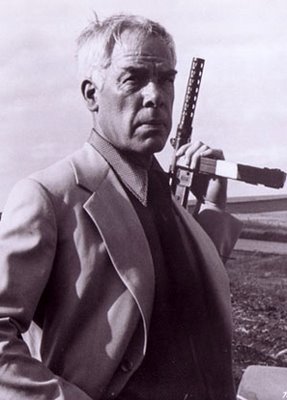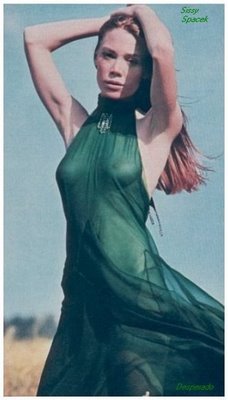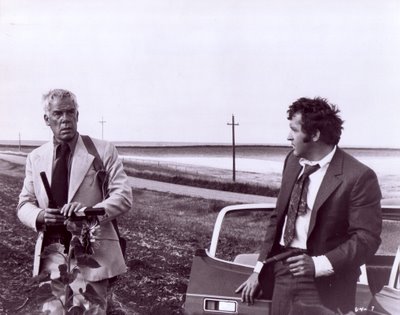come back, lee marvin...we miss you (pt 4)
(WARNING: If you've not seen the movie "Prime Cut", but intend to, this article discusses it in a manner that reveals major plot points. Also, many of the text links lead to nude photographs. Proceed with caution.)
The one 70s film that does rise to Marvin’s level, that does offer a strange and wonderful venue to match his unique persona. As a lover of odd, unexpected gems, even I had trouble believing what was on screen the first time I saw “Prime Cut” (1972; Michael Ritchie). In a nut shell: the Kansas City syndicate is in a power struggle with the Chicago mob, refusing to pay an outstanding debt. When a bagman is sent down there to demand moneys owed, evil crime-boss Mary Ann (Gene Hackman) has him killed, then ground into sausages…a particularly sacrilegious act, when considering the reverence with which Chicagoans hold hot dogs and bratwurst in our choked artery hearts. The Chicago mob hires semi-retired muscle Nick Devlin (Marvin), and he and a crew of young Irish thugs pile into a big black Lincoln and drive out into corn country. Once there, Nick quickly tracks down Mary Ann at a cattle auction. But the livestock pens do not contain animals, but nude teenage girls, passively (they’re drugged) allowing the potential shoppers to examine the merchandise. Mary Ann calmly explains to Nick that he doesn’t need to repay the debt, because “Chicago is dead” (this was, not coincidentally, just a few years after the closing of the infamous Stockyards, removing Chicago’s reign as “hog butcher to the world). Nick is so disgusted by what he sees (while still avoiding a confrontation with the Kansas hoods) that he grabs one of the girls and steals her (Sissy Spacek, in her screen debut).
Back at their hotel, the girl, Poppy, comes out of her drug stupor and excitedly tears into the packages of clothing Nick has bought her. Once dressed (in a see-through evening gown), she tells her sad story; an orphan, she was raised in a foster home that is in reality a training farm for young girls to be prepared for a future of white slavery. All Poppy wants now that she is free is to be reunited with her one friend and fellow pen-mate, Violet (presumably, all the girls had their original identities stolen, rechristened with flower names, to conjure simultaneously a sense of purity and the image of the opening vagina). Nick takes her to a fancy restaurant, where, when he’s not staring down any patrons eyeing the exposure of Poppy’s breasts afforded by the dress he purchased, he starts to fall for the awkward, naïve girl-child. Later, he brings her along on a second attempt to shake down Mary Ann, who’s a judge at the county fair. Once there, Nick and his men discover that the Kansas City crime-boss’ control over the local population is complete, that they are equally in danger with the hayseed public as they are with the professional hoods. It’s also there that Nick discovers his former wife, the grotesque Clarabelle, is now married to Mary Ann, playing hostess to visiting dignitaries (or whatever you call an honored guest of a Kansas county fair).Once Mary Ann gives the signal, his henchmen and the locals turn on Nick, giving chase. One of Nick’s young goons, O’Brien (who had earlier forced Nick to meet his proud family before he would leave Chicago) is gunned down, and the others flee. A morbidly obese farmer chases Nick and Poppy with his thresher, until the remaining members of the Chicago crew arrive and stop him by sacrificing the limousine to the thresher’s blades. Later on, while Nick is visiting his former wife, the Kansas City mob hits their hotel room, killing another of the Irish boys and kidnapping Poppy. Nick goes to the flophouse where Mary Ann’s retarded, sadist brother Weenie lives, hoping to get some information. Instead, he finds Poppy’s friend Violet, semi-nude and trembling in a corner, surrounded by a mob of drunk and lecherous bums. Earlier, she had been Weenie’s personal plaything, forced to wear a red dress and dance with him in his brother’s greenhouse. But Weenie has grown bored with her (perhaps because his attention is now focused on Poppy), and he’s sold her to the flophouse bums, five cents a go. In what might be the most deliciously tasteless moment in a Hollywood movie since Erich Von Stroheim was driven out, Nick forcefully pulls Violet’s clenched fist from her chest, and about six dollars in nickels falls to the floor.
Through out the film, Shaughnessy had been offering Nick his choice of guns from the suitcase they had brought along. Each time he had passed, hoping to persuade Mary Ann with words rather than violence. But seeing poor little Violet, and her fistful of hard-earned coinage, he finally opens the case and starts preparing for the final battle (while real storm clouds and thunder appear on the horizon). Down to his last Irish boy, Shaughnessy, and trusty chauffeur Shay, Nick approaches Mary Ann’s compound, through a field of sunflowers. His two companions are quickly wounded and side-lined, Nick penetrates Mary Ann’s defenses, single-handedly bringing down the entire Kansas City mob…and freeing a menaced but still virginal Poppy. At the film’s end, Nick, Poppy, the wounded but surviving Shay and Shaughnessy and Violet (who appears to now be Shaughnessy’s girl), visit the foster-home/girl-farm. Poppy knocks out the madam who had raised them to be sex-slaves, then liberates all the (presumably flower named) young girls from the evil witch and the degradation their futures promised.
This movie is genuinely bizarre and over the top…which is why I love it so much. It boggles the mind to think that any studio would finance such a twisted, bleak vision… or that such talented stars as Marvin, Spacek and Hackman would have such a sordid affair on their resumes. On a certain level this feels like a b-movie aimed at the drive-in demographic, but it seems unlikely that the mainly rural audience that feeds on cheap thrillers would connect with a movie that seems committed to mocking them. It’s taken as a given in this movie that rural America is populated solely with ugly, ignorant sadists, contrasted with the humanism, wit and decency of the urban gangster. In the film’s opening sequence, Weenie kills and grinds up the bagman sent from Chicago. The movie then cuts to a tour of Michigan Avenue (Chicago at night is one of the most beautiful sites mankind has created), where a Dixieland band serenades the people from the back of a fire truck. Once the hoods leave the city, the scenery transforms into either the colorless wasteland of wheat fields, or the ugly squalor of Kansas City. If the inherent superiority of the city over the country isn’t understood by that point, the filmmakers make it even more clear by contrasting the cleanly dressed, wholesome Irish boys (all with proper, solid names like Delany and O’Brien) against the bare-foot slobs in overalls (with emasculated names like Mary Ann and Weenie). The significance of clothes plays an important role in “Prime Cut”: when Nick Devlin (who is also the only character with both a first and last name) first sees Poppy- she like all the imprisoned sex-slaves- is naked. He wraps her in his coat and carries her away, like a child. It is only once she’s clothed in the elegant green dress he buys her that he begins to appreciate her adult body, through the transparent fabric. At the same time, Weenie forces the naked Violet to put on a red dress before he will fondle her, that she needs to first be dressed before he can strip and rape her. Later, at the county fair, both of the women are dressed in more wholesome garb- Poppy in a virginal white gown, and Violet as a milk maid.
There’s maybe something a little perverse about this strange, little film. While he certainly is offering her a better life by freeing her from slavery, it’s still a little creepy when Nick alternates in his treatment (and dressing) of Poppy between woman and child. In real life, Marvin had a solid quarter century on Sissy Spacek, but the way she plays her part, it feels like an even greater age difference than that. Equally, it’s obvious from the first time Shaughnessy sees Violet at the fair that he’s smitten, and while it’s certainly noble that he ends up with her despite all that she’s been through, I can’t help but wonder if her helplessness isn’t the motivation to his attraction. Until they’re seen embracing each other at the film’s close, the two never meet other than when she is either doped into near catatonia or just after a night of being gang-raped by drunken derelicts. And what of all the little girls set free by Poppy? After the evil foster mother falls to the ground unconscious, the captive little girls break free from the house, no longer facing the certain future degradation as sex-slaves. And while it’s a relief to see the thirteen and fourteen year-old orphans running away from their state of bondage, the movie doesn’t bother to ask where exactly this pack of defenseless little girls is going. Content that they can fend for themselves, the surviving gangsters, with the addition of Poppy and Violet, get in their car and drive off, presumably heading back to the safety and civilization of Chicago. One can only hope these children find themselves their own middle-aged, Irish gangsters to protect them and dress them up in pretty (or sexy) outfits. to be concluded...
Labels: classic movies, cult movies, lee marvin, masculinity, prime cut





0 Comments:
Post a Comment
<< Home